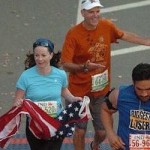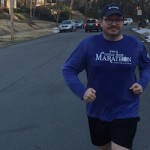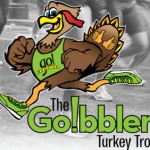 I’ve become what I wrote about in a poem on this site recently: A runner who doesn’t run.
I’ve become what I wrote about in a poem on this site recently: A runner who doesn’t run.
About a month ago, I was out for a much looked-forward-to 10-mile run along the Arkansas River Trail. I felt great: I was rested, carbed up (as always), and the weather was great. At the 6.5-mile mark, though, I knew something was up that I couldn’t just “run through.” (If I have a long run and something starts to hurt, I keep going for awhile to see if it will loosen up or, even better, go away. Usually it does.)
But this was getting worse. This tight, painful twinge below my patella in the center of my knee started at that point and got worse with each stride. Every time I felt the impact, I felt a gradually worsening pain in my left knee. I had to stop.
This was incredibly frustrating because I had been looking forward to the run for a week. I hadn’t run 10 miles since the summer, and that had been on the “dreadmill,” so was not as enjoyable as this one in the fall colors and cooling weather was. I hated to give in to the pain because I felt great in every other way—strong muscles joined with a great headspace for this distance is running serendipity I hated to waste.
So, I stretched and tried again. Within 10 meters, I had to quit. I walked, stretched, and tried again, but it was still painful, and I stopped to stretch and walk. Because I was two miles from my car, getting cold without the warmth generated by running and growing incredibly bored, I kept trying to run without pain after these mini-breaks. Finally, inexplicably, I started running again after about 20 minutes of walking/stretching breaks and nothing went wrong. I ran the remaining 3.5 miles with no problem.
But the next time I ran, this time back on the treadmill, the pain came back after about 4.5 miles. I knew I had to stop to fix it, or I could endanger my running altogether, not just for that day or for the next race.
Now I’m in physical therapy, learning how to improve my stride to provide more stability for my hips and knees, so that what seems to be beginning patellar tendonitis won’t get worse. I’m only allowed to work out in no-impact sessions as long as they don’t cause any pain.
won’t get worse. I’m only allowed to work out in no-impact sessions as long as they don’t cause any pain.
But while I get ready for no-impact Jazzercise and plan my incline-walking sessions, I thought I would talk to a physical therapist who sees these problems every day and get his professional opinion about sports injuries in general. I can always stand to be reminded of healthy practices.
Adam Parker Carson, PT, owns Carson Physical Therapy in Bryant with his wife, Jenny Carson, PT. He’s been practicing physical therapy for 18 years and specializes in orthopedic and manual physical therapy. He provides this advice for both the reluctant and the eager amateur athletes when it comes to injury:
What are some basic things athletes can do to avoid injuries?
Carson advises:
Stretching: This is too often over looked, and should be done with a balanced approach among muscle groups. For example, runners should make sure when they start out that they loosen up hamstrings, quads and calves.
Getting the right shoes: Find the right shoe for you, not what someone else recommended based on their own experience. Regardless of the shoe, make sure you have shock absorption and the right orthotics if you need to correct supination or pronation. Your weak spots will show up—painfully—if you’re not managing all of this correctly.
Not overdoing it: Of course, when you’re training, you’re progressively adding challenges, but work into those challenges reasonably. Set moderate goals and use credible resources to advise you so that you can achieve your aspiration in time. In fact, overdoing it is one of the worst things athletes can do for their long-term health and athletic abilities.
Having an expert review your form: This might be a physical therapist or a running specialist. If you need to adjust your stride length, your heel strike or your push off to avoid future issues, professionals can isolate and help you correct before you have a problem that puts you on the Disabled List.
What should you do if something does go wrong?
Carson says people tend to do one of three things:
- Take the pain as an omen and quit all together.
- Ignore it and keep going.
- Do something to fix the problem so they can keep going.
Athletes tend to follow a “no-pain, no-gain philosophy” but this isn’t going to lead to long-term health. Instead, he says we should make our motto, “No soreness, no gain.” He admits it doesn’t have that same ring, but pain is not a healthy indicator of a work-out’s success. “If your workout isn’t making you sore, then you probably aren’t doing enough; however, if your workout is causing honest-to-goodness pain, then you are doing too much or doing the right thing wrong,” he said.
Physical therapists specialize in it-hurts-when-I-do-this complaints, and if an athlete is experiencing pain that gets worse or doesn’t go away, they can probably help. I was a little afraid of visiting my doctor about my issues, because I thought she might tell me to stop running, but she knows what it means to me and referred me. Physical therapists are there to solve the problem and keep you moving if at all possible, Carson reminded me.
How can runners best cross-train to prevent injury?
Biking, swimming, yoga and weight-lifting are all great, said Carson, but he recommends athletes only add activities they really enjoy. You might want to add something that adds a component you’re not getting on the running path or in the road races, such as strength training or flexibility improvement. Whatever it is, just have fun. You run because you like it, so what you add should be enjoyable too, he advises.
If I’d taken some of this advice before, I might still be out on the running paths and not sitting here writing this column. I may be a reluctant athlete, but I don’t feel like myself when I can’t get out for a run—when I get back to it, I’m going to make sure I protect it more energetically than ever before.
***
Stacey Margaret Jones, M.S., APR, (@sharkushka) is writer and market research consultant. She lives in Conway, Arkansas, with her Chaucerian husband. Jones, a South Dakota native, does not play team sports, unless you consider cocktailing a competitive event.












